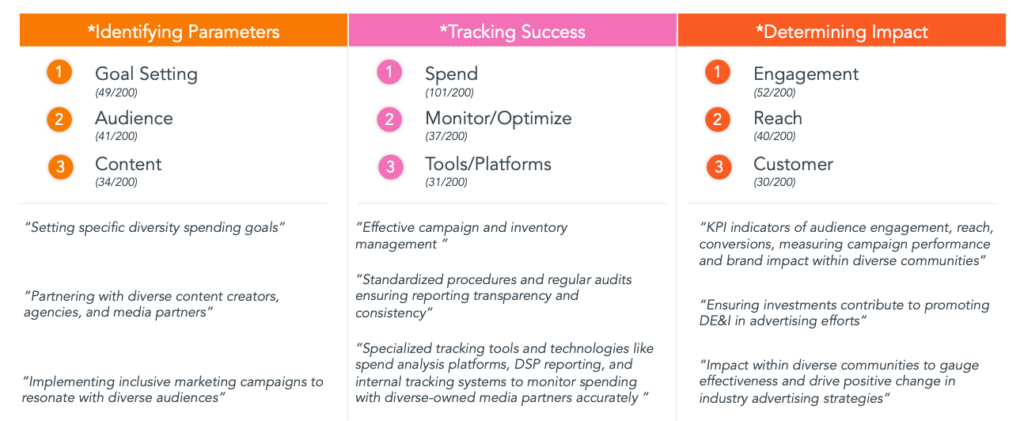State of DE&I Investment in Digital Advertising
Explore the findings from our report dedicated to improving investment in diverse-owned media.
Background
Market confusion, the inability to define successful DE&I investment with digital budgets, and barriers to entry for smaller diverse-owned publishers remain prevalent issues.
To confirm or disprove our hypothesis, we surveyed 200 Digital Marketers with a dedicated DE&I budget, and 100 Diverse-owned Digital Publishers.
What We Learned
- DE&I digital budgets continue to grow, but are challenged by a perceived lack of scalable inventory.
- Programmatic advertising is the most utilized and effective method in reaching DE&I spend goals and driving scale.
- Marketers and Publishers want scalable inventory and industry standards.
- There’s a strong desire for a solution to tracking success.
Defining & Dictating Commitments
Publishers & Marketers Define DE&I Budget Commitments Differently
9 in 10 marketers define a commitment to DE&I in digital advertising as prioritizing diverse-owned publishers, however, publishers don’t feel that they are the focal point. Marketers must ensure their commitments are transparent and aligned with publisher expectations.
Marketers Need to Make Source of DE&I Commitment Clear
Publishers are unaware that a significant percentage (49%) of marketers’ commitments to DE&I in digital advertising at the brand level. Publishers may see DE&I as merely a corporate formality, devaluing its role in digital advertising. Brands and agencies must clearly share responsibility for setting goals and supporting overall corporate DE&I commitments.
Common Ground
Programmatic Seen as the Most Effective and Utilized Way to Buy & Sell Diverse-owned Media
While programmatic methods are the most commonly used and recognized as effective, direct collaboration with individual publishers is still seen by both marketers and publishers as highly effective. However, due to its inefficiency, this approach is less utilized. To capitalize on programmatic efficiency while preserving the unique voice of each publisher, Ad Tech must innovate and educate the industry about solutions that strike a balance, such as Private Marketplaces (PMPs), Programmatic Guaranteed, and Contextual Targeting.
Barriers to Entry Apparent in Shared Challenges
Looking beyond Brand Safety & Ad Fraud, 44% of marketers site DOM-certified partner scarcity as a primary challenge in leveraging programmatic DE&I budget.
All diverse-owned publishers who took the survey cited barriers related to ad tech as primary challenges.
The barriers to entry for diverse-owned publishers into programmatic inventory come directly from Ad Tech in the form of technological difficulties integrating, too-high inventory minimums, and lack of support for ad operations and data management. The solution is for publishers to partner with Ad Tech platforms that are committed to growing the quality and scale of their inventory.
Industry Standards and More Inventory Are Desired
by Marketers & Diverse-Owned Media
“Industry Standards” and “More Inventory” were the most chosen options by each respondent group.
Certifications (58%) were also cited as future hopes indicating a need to standardize certifications for DOM in programmatic.
Success Metrics
Defining and Identifying Success can be Elusive for Marketers
When asked how success is determined, the responses were incredibly varied. The majority see success as just an element of spend. However, a good portion of marketers see success as just identifying/setting a goal. A set process for measuring success (action, impact, and iteration) was lacking.

For more information on DE&I, and other topics ranging from CTV to sustainability, make sure to head to our resources hub.

